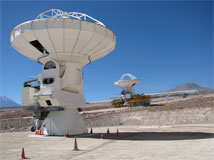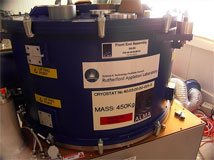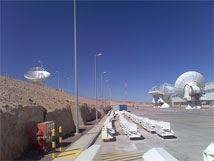
Figure 1. The second Vertex antenna accepted by ALMA moves on a transporter toward the Operations Support Facility. In the foreground stands the next antenna in the queue. Photo courtesy N. Emerson.

Figure 1. The second Vertex antenna accepted by ALMA moves on a transporter toward the Operations Support Facility. In the foreground stands the next antenna in the queue. Photo courtesy N. Emerson.

Figure 2 The third ALMA Front End was shipped intact from the European Front End Integration Center and arrived in fine shape. After passing its tests, it is ready for installation in the third ALMA antenna. Photo courtesy D. Barkats.

Figure 4. The two antennas facing the camera were the first accepted by ALMA: an NAOJ antenna (left) and an NRAO antenna (right). In the distance is the second NRAO antenna accepted by ALMA. In the foreground is Vertex No 4, undergoing tests but not yet accepted by ALMA. Photo courtesy L. Knee.
On 29 April 2009, the second Atacama Large Millimeter/submillimeter Array (ALMA) production antenna designed and built by the Vertex division of General Dynamics Corp. under contract with Associated Universities, Inc. conditionally passed its acceptance tests and was accepted by the project. An ALMA transporter moved this antenna to foundation No. 4 at the nearby Operations Support Facility (OSF) and antenna outfitting began immediately. This antenna will be equipped with the Front End recently delivered from the European Front End Integration Center at Rutherford Appleton Labs.
With the arrival of the pedestal structure on 18 April, all the major parts for the first European antenna had arrived at the contractor's OSF site.
The two antennas that have been outfitted and characterized by the ALMA teams over the past months now have their surfaces set to much better than the 25 micron specification when pointed at an elevation of 50 degrees, the so-called "rigging angle." Both antennas have had their individual parameters— e.g., pointing and focus models—determined through total power tests run by the AIV (Assembly, Integration and Verification) team led by Joe McMullin, and by the science team led by Alison Peck. As a measure of merit of these models, both antennas were pointed at the holography tower in early April and 'static fringes' were observed from the beacon used for holography. Doing this on an astronomical source requires good focus and pointing. During April, numerous observations of stellar SiO masers have yielded good radiometric pointing models. On 30 April, both antennas were pointed at an astronomical source, Mars, and static fringes were observed. Present at the event were Gene Duvall, Dick Sramek, Lewis Knee, Norman Saez, and Hector Alarcon with off-site support from Peter Napier and Darrel Emerson. The team will proceed with the next steps, culminating with ALMA software controlling all aspects of the observation—in the recent Mars observation, e.g., the geometric delay in the signal paths between the two antennas was calculated independently. The next software implementation will contain all of the functionality to do this and other calculations automatically. When this occurs in June, we will refer to the fringes as "dynamic."